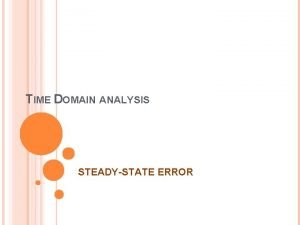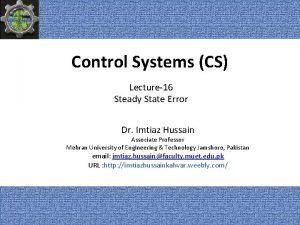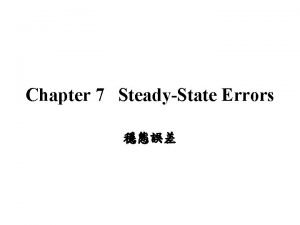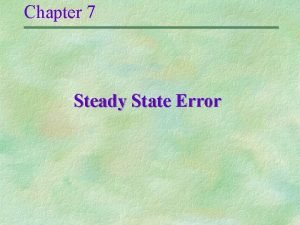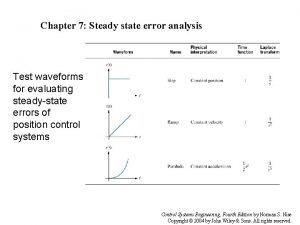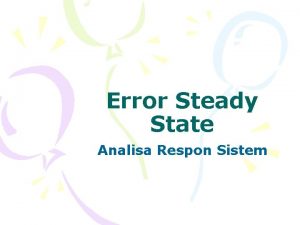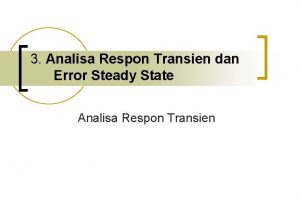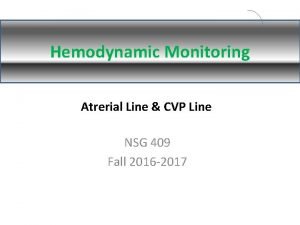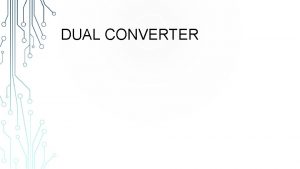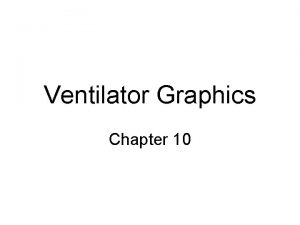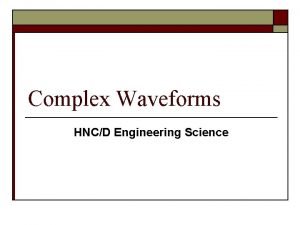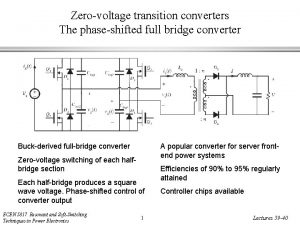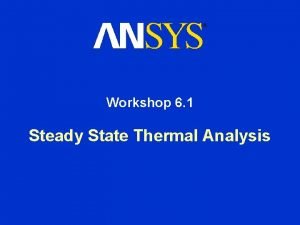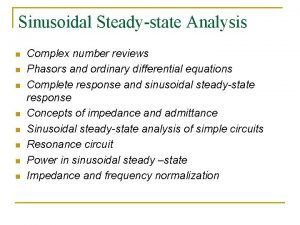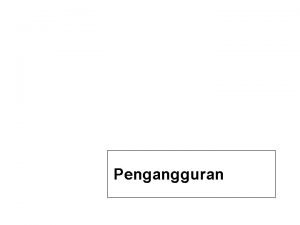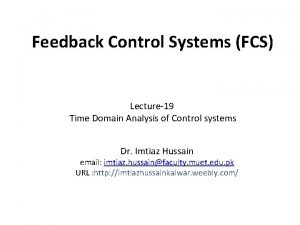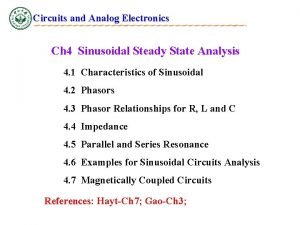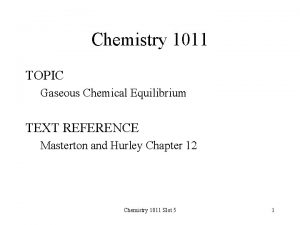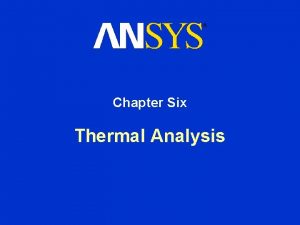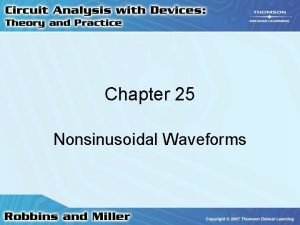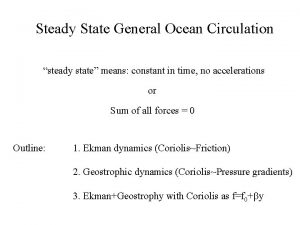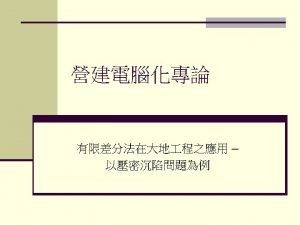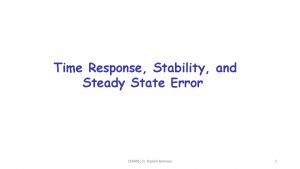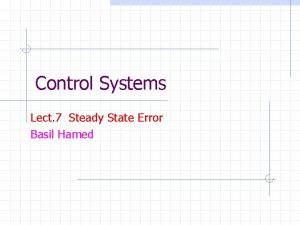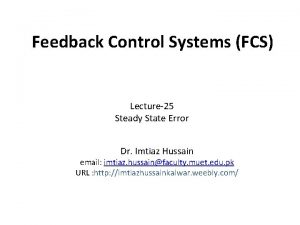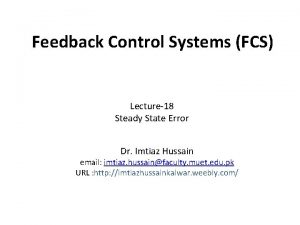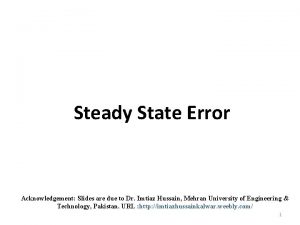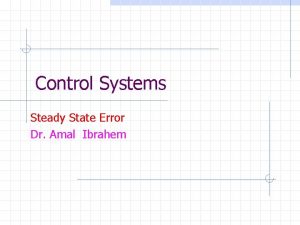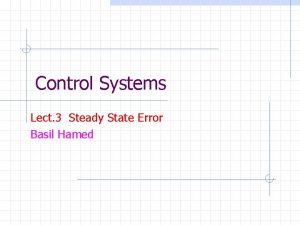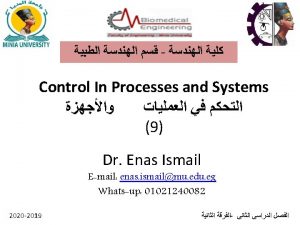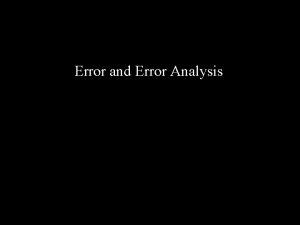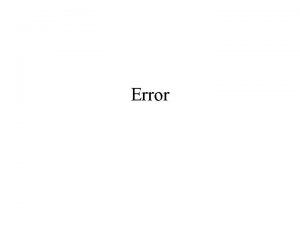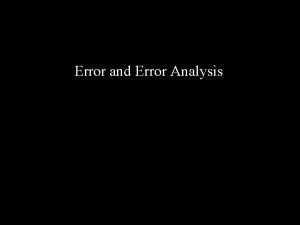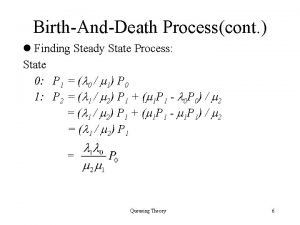Chapter 7 Steady State Error Test waveforms for

























- Slides: 25

Chapter 7 Steady State Error

Test waveforms for evaluating steady-state errors of position control systems Steady-state error is the difference between the input and the output for a prescribed test input as t →∞

Test inputs for steady-state error analysis and design vary with target type

Steady-state error: a. step input; b. ramp input

Closed-loop control system error: a. general representation; b. representation for unity feedback systems

System with: a. finite steady-state error for a step input; b. zero steady-state error for step input For pure gain K as in (a), Css= K ess or ess =1/K Css there will always be error But if the pure gain is replaced by an integrator as in (b) the steady state error will be zero.

Feedback control system for Example 7. 1 Problem Find the steady-state error for the system in(a) if T(s) = 5/(s 2+7 s+10) and the input is a unit step. Solution: Using E(s) = R(s)[1 -T(s)] We can apply the final value theorem To yield e(∞) =1/2

Steady-state error in terms of G(s) E(s) =R(s) – C(s), C(s) =E(s)G(s) so E(s) = R(s)/1+G(s) Using final value theorem

Steady-state error in terms of G(s) For step input, the steady state error will be zero if there is at least one pure integration in the forward path. For ramp input, the steady state error will be zero if there is at least 2 pure integration in the forward path. For parabolic input, the steady state error will be zero if there is at least 3 pure integration in the forward path.

Steady state error for systems with no integrations Problem Find the steady-state error for inputs 5 u(t), 5 tu(t), and 5 t 2 u(t) to the system. u(t) is a step function. Solution First verify the closed loop system is stable. For input 5 u(t) For input 5 t 2 u(t)

Steady state error for systems with one integration Problem Find the steady-state error for inputs 5 u(t), 5 tu(t), and 5 t 2 u(t) to the system. u(t) is a step function. Solution First verify the closed loop system is stable. For input 5 u(t) For input 5 t 2 u(t)

Static error constants Position constant step input Velocity constant ramp input Acceleration constant parabolic input

Steady state error via static error constants Problem For the system of figure, evaluate the static error constants and find the expected error for standard step, ramp, and parabolic inputs. . Solution First verify the closed loop system is stable. Thus for step input, For ramp input For parabolic input

Steady state error via static error constants Problem For the system of figure, evaluate the static error constants and find the expected error for standard step, ramp, and parabolic inputs. Solution First verify the closed loop system is stable. Thus for step input, For ramp input For parabolic input

Steady state error via static error constants Problem For the system of figure, evaluate the static error constants and find the expected error for standard step, ramp, and parabolic inputs. Solution First verify the closed loop system is stable. Thus for step input, For ramp input For parabolic input

Feedback control system for defining system type System type is the value of n in the denominator, or the number of pure integrations in the forward path.

Relationships between input, system type, static error constants, and steady-state errors

Feedback control system for Example 7. 6 Problem Find the value of K so that there is 10% error in the steady state. . Solution: Since the system is Type 1, the error must apply to a ramp input, thus and K = 672 Applying Routh-Hurwitz we see that the system is stable at this gain.

Feedback control system showing disturbance Applying final value theorem we obtain

Previous system rearranged to show disturbance as input and error as output, with R(s) = 0 Assume step disturbance D(s) = 1/s We get This shows that the steady-state error produced by a step disturbance can be reduced by increasing the dc gain of G 1(s) or decreasing the dc gain of G 2(s)

Feedback control system for Example 7. 7 Problem Find the steady state error due to a step disturbance for the shown system. . Solution: The system is stable, we find

Forming an equivalent unity feedback system from a general non-unity feedback system G(s) = G 1(s)G 2(s) H(s) = H 1(s)/G 1(s)

Non-unity feedback control system for Example 7. 8 Problem Find the system type, the appropriate error constant, and the steady state error for a unit step input. . Solution: The system is stable, we convert the system into an equivalent unity feedback system The system is Type 0, and Kp= -5/4. The steady-state error is

Steady-State error for systems in State Space The Laplace transform of the error is E(s) = R(s) –Y(s), and since Y(s) = R(s)T(s). Then E(s) = R(s)[1 -T(s)] Using T(s) =Y(s)/U(s) = C(s. I-A)-1 B + D We have E(s) = R(s)[1 -C(s. I-A)-1 B] Applying final value theorem, we have

Steady-State error for systems in State Space Example: Evaluate the ss error for the system described by Solution: Substitute A, B, and C in For unit step, R(s)=1/s and e(∞)=4/5, for unit ramp, R(s) = 1/s 2 and e(∞)= ∞
 In time domain analysis, finite steady state error is
In time domain analysis, finite steady state error is What are static error constants
What are static error constants Control system type 0 1 2
Control system type 0 1 2 Steady state error of closed loop system
Steady state error of closed loop system Steady state error in control system
Steady state error in control system Error steady state adalah
Error steady state adalah Respon transien orde 1
Respon transien orde 1 Steady state walk test
Steady state walk test Icp waves a b c
Icp waves a b c Calculate mean arterial pressure
Calculate mean arterial pressure Single phase dual converter waveforms
Single phase dual converter waveforms Ac waveforms
Ac waveforms Ventilator graphics
Ventilator graphics Complex waveforms
Complex waveforms Buck converters
Buck converters Ansys steady state thermal tutorial
Ansys steady state thermal tutorial Sinusoidal steady state
Sinusoidal steady state Pengangguran alamiah adalah
Pengangguran alamiah adalah Mitokondre
Mitokondre Nicole menten
Nicole menten What is steady flow process in thermodynamics
What is steady flow process in thermodynamics Steady state response in control system
Steady state response in control system In a normal operations/steady state eoc activation level,
In a normal operations/steady state eoc activation level, Complex impedances
Complex impedances Steady state vs equilibrium
Steady state vs equilibrium What is steady-state thermal analysis?
What is steady-state thermal analysis?
